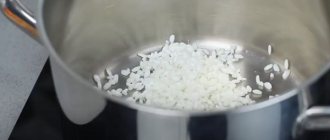In the first months after the birth of a child, everything is clear with nutrition - it can be breastfeeding or specialized formulas. However, as the baby grows up, parents have many questions related to the introduction of new products into his diet, including cow's milk.
So, at what age should you start giving your child this dairy product and in what quantity? Is it always beneficial for the child’s body?
Benefits of cow's milk
First of all, the benefit of the product lies in its composition, which includes a huge number of different macro and microelements. The most significant include: calcium, potassium, magnesium, phosphorus, chlorine, sulfur, iron, copper, zinc and many others.
Cow's milk has a number of beneficial properties, namely:
- has a bactericidal effect on the body;
- helps strengthen the immune system;
- calcium and phosphorus improve the condition of hair, teeth, nails, skin;
- is an effective remedy in the fight against insomnia and depression;
- the saturated acids that make up this product regulate the activity of the human central nervous system;
- lactose normalizes intestinal function, protecting it from the development of harmful microflora, and also promotes better absorption of calcium;
- fats and proteins present in milk are an excellent means for restoring the body after grueling physical and mental stress;
- potassium, calcium, vitamins B12 regulate the functioning of the cardiovascular system, and also normalize metabolic processes;
- milk is an effective remedy in the fight against coughs and colds (it warms the throat and has an expectorant effect);
Cow's milk has a good taste and is also an indispensable component in the manufacture of many products (for example, cottage cheese, feta cheese, sour cream, cheese).
With age, the benefits of milk for the body decrease. The fact is that in most adults, the body stops absorbing the product, so preference is given to fermented milk.
Important information
If you constantly add cow's milk to your child's food or give it frequently as a drink, the child may become dehydrated and may develop an allergy to milk protein. At what age can children have cow's milk? Pediatricians say no earlier than 12 months, and if possible, from 1.5 to 2 years.
Otherwise, introducing this product into the diet too early may affect the occurrence of certain diseases, for example, iron deficiency anemia. At the same time, there is a possibility of developing type 1 diabetes mellitus, a serious disease associated with metabolic disorders.
If there are insulin-dependent patients in the family, we advise you not to include foods that contain unadapted protein in your diet.
Is it worth using for up to a year?
It is not recommended to give cow's milk to a child under 12 months of age, as at this age it can cause harm to the fragile child's body. Doctors explain this fact as follows.
As you know, cow's milk contains a lot of calcium and phosphorus. But an excess of these substances has an extremely negative effect on immature children’s kidneys, placing a heavy burden on them. The risk increases especially for children under one year of age.
Even if milk is diluted with water, in the future this can still lead to disruption of the metabolism of phosphorus, calcium, and vitamin D.
When can you give it to your child?
Cow's milk should be introduced into children's diets no earlier than one year. At the same time, if the mother has lost breast milk and the child has not yet reached 12 months, then it is better to replace it with a special formula. Despite the fact that artificial nutrition is also based on cow's milk, it is nevertheless not the same thing. The mixture undergoes purification and artificially adapts its composition to that of a woman.
There are less strict rules for fermented milk products. Thus, cottage cheese can be introduced into the diet from 7 months, and kefir, yogurt and fermented baked milk - at 8-9 months.
Myth one
All babies can digest cow's milk, but when they grow up, they stop.
There was a belief that children have special lacto enzymes that can break down protein from cow's milk, but they disappear with age. Recent studies have refuted this theory - a person with a healthy digestive system, without an allergy to cow's milk protein or lactose intolerance (lactase deficiency) can drink milk until old age.
But it is not recommended at all to give cow’s milk as a separate food product to children under 12 months of age - their delicate gastrointestinal tract, immature excretory system and metabolism are not yet ready to absorb this product.
Some babies may lack lactase in their intestines, a special enzyme responsible for the breakdown of milk sugar. Usually, with age, the enzyme systems of the digestive tract mature and everything gets better. And if lactase deficiency is congenital, then, depending on its severity, dairy products are excluded from the diet or replaced with low-lactose ones.
Acceptable quantity and input rules
For a child from 1 year to 3 years old, the permissible amount of cow's milk is 200 ml per day. You need to introduce it into your diet correctly:
- The baby should gradually try and learn a new product. It is unacceptable to give your child a whole portion for the first time. This should be done gradually, starting with a small amount.
- Initially, it is recommended to give 20-30 ml in the proportion: 1 part milk and 2 parts water.
- After a few weeks (in the absence of a negative reaction from the body), you can dilute 1 part milk with 1 part water.
- After the child gets used to it, cow's milk can be poured into a bottle and given as a drink, not forgetting the permissible amount.
After introducing a dairy product into the children's menu, you need to carefully monitor the child's condition. It is very important to recognize the signs of cow protein allergy and lactose intolerance early.
It is strongly recommended not to exceed the permissible limit of cow's milk. Thus, excessive consumption of such a drink causes dehydration of the child’s body and predisposes to the development of allergic reactions.
Cow's milk for a baby: when, how and how much?
Milk contains in an optimal and balanced ratio practically all the essential nutrients necessary for the growth and development of a child. This product is easily absorbed by the child's body.
Its important components are proteins necessary for growth, hematopoietic processes, and the functioning of many organs and systems. Milk proteins are easily absorbed and digested, and also contain 8 essential amino acids that are not formed in the body, but must be supplied with food.
Milk fats contain essential polyunsaturated fatty acids necessary for building cells of the nervous system, as well as various complex fat-like compounds involved in the regulation of many metabolic processes. Milk fat is found in milk in the form of small balls suspended in water, so it is well absorbed by the baby’s body.
Milk carbohydrates are represented by milk sugar - lactose, which is easily digestible and serves as the main source of energy and promotes better absorption of calcium. Lactose is the optimal environment for the development of beneficial intestinal microflora, which prevents the growth of pathogenic microorganisms.
Milk also contains such important minerals as calcium, phosphorus, sodium and magnesium, and potassium. Calcium and phosphorus are especially necessary for young children during the period of growth, formation of bones and teeth. Milk contains microelements such as copper, cobalt, and iron in smaller quantities.
Milk contains almost all known vitamins; it is especially rich in vitamins A, C, E, K, PP, folic and pantothenic acids.
In addition to the listed substances, milk contains a number of enzymes that accelerate and regulate the biochemical processes of the body. This is a lipase that breaks down milk fat, as well as a phosphatase that regulates phosphorus metabolism.
Milk contains a number of hormones that are necessary for many metabolic processes: inulin, thyroxine, etc.
Fresh milk contains antimicrobial factors that protect the body from infection.
Milk for a child: benefit or harm?
Despite all the advantages of this product, there are several reasons why whole cow's milk is not recommended for children under one year of age. First of all, this is the imbalance in the composition of whole milk and the discrepancy between its qualitative and quantitative composition and the needs of the child. The amount of protein in cow's milk is 30-35 g/l, which is much higher than its content in breast milk (9-10 g/l), this significantly increases the load on the baby's kidneys. Protein overload is one of the main reasons why whole milk is not recommended for use in the nutrition of children in the first months of life.
The content of calcium and phosphorus and sodium in whole milk is much higher than what a small child needs. On the contrary, the amount of a number of vitamins, essential fatty acids, iron and carbohydrates in it is lower than what the baby needs.
Inconsistency with the age-related needs of an infant and an imbalance in the composition of whole cow's milk lead to poorer absorption and deficiency of some beneficial nutrients. Feeding children under one year of age exclusively with whole cow's milk inevitably leads to a deficiency of iron and vitamins, which entails impaired growth and development of the baby. In addition, whole cow's milk can cause minor hemorrhages on the mucous membrane. The amount of blood lost through these hemorrhages can average 1.7 ml per day, and iron is also lost along with it, which of course negatively affects the baby’s condition. After all, this can lead to a decrease in blood hemoglobin levels and anemia. The specific protein or group of proteins responsible for this phenomenon has not been identified, nor have the exact mechanisms of these microscopic bleeding events. The younger the child, the more likely it is that whole cow's milk will cause such bleeding. Only by the age of 12 months, according to some studies, cow's milk no longer causes a significant increase in hemoglobin loss in feces.
An important reason why you should not give your baby whole milk is “milk allergy”. Cow's milk protein is a potential allergen, so when consuming dairy products, babies often experience allergic reactions, which are manifested by redness, dryness, peeling of the skin (manifestations of atopic dermatitis). With an intestinal allergy, stools may become frequent and thin, and mucus may appear in the stool.
Allergy to cow's milk protein in a child: will it go away? Cow's milk protein is the most common cause of food allergies in infants. Allergies to it occur in 2–7% of formula-fed children and in 0.5–1.5% of breast-fed children. Among patients with atopic dermatitis, 85–90% of children are diagnosed with an allergy to cow's milk protein. It should be noted that allergy to cow's milk protein is a temporary condition. In 80–90% of cases it ends in recovery and disappears at the age of 1.5–3 years.
Milk for baby: when to start?
The basis of nutrition for babies under 1 year of age is breast milk. If the mother does not have enough of it or does not have it at all, then it must be replaced with an adapted milk formula. Most of them are prepared with cow's milk. The goal of manufacturers is to bring this food product as close as possible in its composition to breast milk. To do this, the amount of protein in cow's milk is reduced, the mixture is saturated with useful substances that are not enough in the original product to meet the baby's needs - vitamins, polyunsaturated fatty acids, etc.
Up to a year, when preparing complementary foods, such as porridge, if necessary, you should add breast milk or the milk formula that you feed your baby.
After a year, you can introduce whole cow's milk into your child's menu. The total daily volume of whole milk and fermented milk products for a child from 1 year to 3 years is 400–600 ml, including milk added to porridge and milk soup. It is acceptable if the baby drinks one glass of whole milk per day, and the rest of the daily intake of dairy products can be used for preparing dishes - porridges and soups.
It should be remembered that milk is not a thirst-quenching liquid, but a complete nutritious product!
How to choose milk for a baby?
When purchasing milk, you should pay attention to its shelf life. Milk can be stored long-term or short-term - the difference lies in the temperature treatment the product has undergone. Heat treatment is carried out in order to ensure the microbial safety of the product.
Milk sold on sale may be sterilized or pasteurized. During sterilization, milk is heated to 135–138°C in a very short period of time and then cooled further. The loss of nutritional value of such milk is very small; shelf life can be about 3 months, sometimes more. During pasteurization, milk is heated to a lower temperature - 60–70 ° C and maintained at this temperature for some time. Nutrients and vitamins are destroyed during pasteurization to an even lesser extent than during sterilization, but microorganism spores retain their viability, so the shelf life of pasteurized milk is a maximum of 5–6 days.
It is better not to use skim milk for feeding small children. The baby’s digestive system easily absorbs milk fat, which has a high energy potential, and the needs for energy and fat-soluble vitamins at this age are especially high. Skim milk or milk with a fat content of 0.5 to 2% has much lower energy potential and contains fewer fat-soluble vitamins, which are necessary for the growth and development of the baby. It’s also not worth diluting whole cow’s milk, since after a year a child’s body is well adapted to digesting whole milk, and when diluted, as well as in the process of skimming, the nutritional value of the product is significantly reduced.
Despite the fact that after a year it is quite possible to use dairy products that are intended for general consumption, the ideal option for a baby would be special milk, which is sold in baby food departments. It undergoes additional quality control and has a balanced protein-fat composition. You should pay attention to the label indicating at what age it is recommended to give this product to your child, for example from 8 months, from 1 year or from 3 years, as well as the expiration date.
Separately, it is worth mentioning the misconception of some parents regarding fresh milk “from the cow”. Fresh whole cow's milk undoubtedly has high nutritional value and good taste, but its microbial safety is not always reliable. When purchasing this valuable product, parents must be sure that milk suppliers comply with all sanitary, hygienic and veterinary standards. Before consuming such a product, even if the milk comes from your own cow, it must be boiled. Of course, some beneficial substances will be destroyed when boiled, but this will ensure microbial safety, which is very important, since diseases such as viral encephalitis (inflammation of the brain), as well as intestinal infections, foot-and-mouth disease, plague, etc. can be transmitted through milk. Unboiled milk should not be given to a child of any age.
Do you need to boil cow's milk?
It depends on how you purchase milk. There are two possible options:
- purchased from a farmer at the market or received on your own farm;
- store-bought milk.
In the first case, the product must definitely undergo heat treatment, since raw milk contains a large number of pathogenic bacteria. They can get there from the skin of a cow, the hands of a milkmaid, from the air, etc. It doesn’t matter whether the product was purchased on the market or obtained on your own farm.
If we are talking about milk bought in a store, then everything is not so categorical. So, if the packaging contains a mark indicating that it has undergone heat treatment (for example, ultra-pasteurized), then in this case it can be safely given in the form in which it is sold.
Which cow's milk to choose for a child in the store
The most useful product is considered to be one obtained from your own cow or purchased from a proven thrush. But if we are talking about a child’s body, then this statement is called into question, since in this case more stringent requirements for fat content and heat treatment are imposed on the product.
When buying store-bought milk, preference should be given to milk that is saturated with various beneficial substances and is fully adapted to the child’s body.
When choosing milk, you need to pay attention to the following important points:
- The procedure for carrying out heat treatment - there are several methods: pasteurization, sterilization, ultra-pasteurization. The third option is the best. This processing is carried out using a special technology, which makes this drink safe for consumption and preserves its beneficial properties. In addition, UHT milk has a long shelf life and can be refrigerated for more than a month.
- Fat level - children under 3 years old should not be given dairy products with a fat content of more than 4.5%.
- Expiration date - before purchasing, it is important to look at the manufacturing date on the packaging. The product must not be expired.
- Composition - even if we are talking about baby milk, before buying it you should familiarize yourself with the composition. It should not contain dyes, preservatives, palm oil and other dubious components.
- Appearance of the packaging : it must be intact and sealed.
Signs of intolerance
Some children experience a phenomenon called intolerance to cow protein (casein), which causes a certain reaction in the body to dairy products.
This pathology is characterized by a lack of enzymes necessary to digest the protein contained in cow's milk. Casein intolerance is the result of immaturity of the baby’s enzyme systems, which causes problems with digesting dairy products.
So, signs of cow protein intolerance in a child include:
- pain, bloating, increased gas formation;
- general weakness throughout the body;
- wheezing, cough, runny nose;
- skin manifestations (severe itching, redness, dermatitis, excessive dryness of the skin);
- frequent bowel movements, diarrhea;
- high temperature, chills;
- nausea, vomiting;
- dizziness.
In more severe cases, children sometimes experience seizures.
The reasons for the development of this pathology lie in genetic predisposition, the development of inflammatory processes (for example, influenza), and surgical intervention in the stomach or intestines.
Contraindications
Cow's milk is contraindicated for children with:
- lactose intolerance;
- allergies to cow protein;
- diseases of the digestive system;
- metabolic disorders;
- kidney diseases.
Despite the fact that milk is considered a healthy drink, it should be introduced with caution into children's diets. Moreover, it is better not to rush and wait until the baby reaches the age of 12 months. In this case, you should only choose a high-quality product produced by baby food manufacturers.
Views:
7536.
Dairy affairs
Here are some tips on how to make sure milk has an appropriate place on your baby's menu.
- Children under one year of age should never be given regular cow's milk.
If you are not breastfeeding, switch your baby to formula. They break milk molecules into smaller parts that are easier to digest. Unprocessed cow's milk can cause a reaction in the baby's intestines, which leads to permanent inflammation of the intestinal walls and disruption of its functions. (After a year, the baby will be able to digest milk more easily and safely). In addition, there is evidence that children drinking milk at an early age is associated with allergies that arise later.
- In everything you need to know when to stop.
Some children drink so much milk that they are reluctant to eat more nutritious foods. The child may continue to gain weight and grow, but his nutrition will be unbalanced. Children aged one to three years need 450 to 600 ml of milk and dairy products per day. (2-3 medium glasses). However, milk is low in iron, fiber, zinc and other nutrients your baby needs to develop.
- Not all babies tolerate milk.
A true milk allergy—where the body perceives it as a foreign object and forms antibodies to fight it—can be very serious. If a child has this type of allergy, even a small amount of milk within a few minutes will cause reactions such as vomiting, diarrhea, itching of the face, mouth or entire body, swelling of the lips and eyes, wheezing or difficulty breathing. Fortunately, such severe reactions are quite rare, but if your child is diagnosed with such an allergy, you should not give him anything containing milk. Parents of such children should carefully read the ingredients of products before giving them to their child. Children often outgrow this allergy, but if it first appears in children over three years of age, there is a chance that it will remain for life.
- Lactose intolerance is more common than milk allergy.
Lactose, a type of sugar found in milk, is difficult for many people to digest. The degree of bloating, gas, and abdominal pain associated with lactose intolerance depends on the amount of milk you drink. Many children with this problem cannot digest plain milk, but can eat foods such as yogurt and cheese. At the same time, it would be better to switch to lactose-free products for a while. If your child is persistently lactose intolerant, your pediatrician can help you choose a milk replacement.
- Not all children like milk.
If your child refuses to drink milk and does not have digestive problems or allergies, try flavoring the milk with chocolate, strawberry, vanilla, or any other flavor your child likes. If the baby does not want or cannot drink milk, replace it with other products containing calcium, such as cottage cheese, yogurt, cheese, kefir. If you have any doubts whether your child is absorbing calcium well, contact your pediatrician.
If you don't want to give your baby milk, make sure the milk replacement drink contains vitamins A and D. Isolated cases of rickets, a disease caused by calcium deficiency and now rare thanks to the addition of vitamins to milk, have been recorded again as children replace milk with less healthy drinks. Consult your pediatrician to ensure you are choosing the right product.











